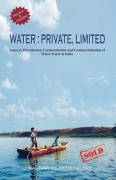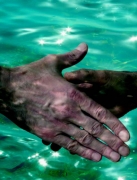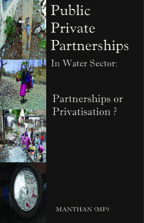Books and Book Reviews
Seeds of hope - Case studies from the Planning Commission and Lokayan
Posted on 12 Jul, 2010 03:33 AMThis set of case studies is part of a book prepared by Lokayan in collaboration with the Planning Commission titled “Seeds of Hope", covers themes of agricultur
Neel Ka Dhabba - Sansthayen Narayan Parayan Bane: Essays in Hindi by Mahatma Gandhi and Vinobha Bhave
Posted on 17 Jun, 2010 01:05 AMNeel Ka Dhabba recounts how Gandhiji washed away the stain of cruel oppression of Champaran's Indigo farmers forcibly made to grow Indigo by processors-traders, using caution, non-violence, courage and humility. The essay is narrated by Gandhiji himself.
In Sansthayen Narayan Parayan Bane, Acharya Vinoba takes a critical look at the work of voluntary development organisations, and details what and how their goals, functioning and funds management should be.

Water: Private, Limited - Issues in privatisation, corporatisation and commercialisation of water sector in India by Manthan Adhyayan Kendra
Posted on 31 May, 2010 02:44 PM This book by Manthan Adhyayan Kendra, highlights the emerging issues related to privatisation of water in the context of the recent surge of privatisation-related initiatives in the water sector in India.
This book by Manthan Adhyayan Kendra, highlights the emerging issues related to privatisation of water in the context of the recent surge of privatisation-related initiatives in the water sector in India.
The history of attempts at privatisation of water till recent times from all across the globe indicate that they have been met with strong resistance where ever they have been implemented. This is because of the total failure of all these programmes to address the social responsibility of providing water to all without consideration of profits.
However, this backlash against privatisation has led international donor agencies to use a different type of strategy and language. This has led to a shift from Private Sector Partnership (PSP) to Public Private Partnership (PPP) and more recently to the Water Sector Reforms (WSR) in countries such as India.
Negotiate: Reaching agreements over water - Paper by IUCN
Posted on 25 May, 2010 06:49 PM This book by IUCN is directed at practitioners involved in water-related negotiations that aim at fair and mutual agreements on optimum and sensible use of water by all. The book provides the necessary motivation, ideas, tools and inspiration for people involved in water negotiations throughout the world.
This book by IUCN is directed at practitioners involved in water-related negotiations that aim at fair and mutual agreements on optimum and sensible use of water by all. The book provides the necessary motivation, ideas, tools and inspiration for people involved in water negotiations throughout the world.
Many a times, the underlying approach to negotiations involves bargaining and competition. However, the book believes that emphasis on constructive engagement involving multiple perspectives and consensus building can lead to fair and equal distribution of this valuable resource to everyone.
The book is divided into five chapters that give out important key messages as to how to go about the process of negotiating:
Silviculture of Indian Trees:A book by Robert Scott Troup
Posted on 06 Mar, 2010 11:10 AMThe Silviculture of Indian Trees, is a seminal reference work in three volumes, that contains in-depth information (from a silvicultural point of view) about nearly all tree species of India, covering some 63 botanical orders. It is the outcome of twenty years of field-based research by Robert Scott Troup, a British forestry expert who spent much of his career in India, and is considered a classic landmark work on the subject.
The book starts with an introduction, followed by information organised by the botanical order, genera and finally, species. Each sub-section on a specific species, contains details such as the botanical name, vernacular names, distribution and habitat, silvicultural characters (climatic, temperature, soil conditions that help the tree grow), botanical descriptions as well as silhoutte drawings of the seed seedling leaf trunk root flower fruit bark and other plant parts, uses, flowering fruiting and leaf-shedding process as well as season, natural and artificial reproduction methods and rate of growth, germination process and role of animals birds insects wind and water, and botanically allied species.

Geology of India - DN Wadia - Macmillan publishers (1919)
Posted on 01 Mar, 2010 12:10 AMThe Geology of India by DN Wadia, a geologist with the Geological Survey of India, is considered to be one of the most important and complete reference works available today on the subject.
The book divides India into three main geological divisions - the triangular plateau of the peninsula, the mountainous or the extra-peninsular region bordering India on the west north and east, and the Indo-gangetic plain extending from the valley of the Indus to the valley of the Brahmaputra in Assam. The desert region of western Rajasthan is considered to be a unique fourth category, as it combines characteristics of two of the three main divisions.

Book : "Public-Private Partnerships in Water Sector: Partnerships or Privatisation?"
Posted on 01 Feb, 2010 05:17 PMAbout the Book –

Public-Private Partnerships (PPPs) are supposed to provide solutions to many of the existing problems related to infrastructure projects – in both execution and operation. Currently, there are PPP projects in almost all the sectors including roads, ports, airports, water, sewerage, solid waste management and transport among others. It is, therefore, important to do a reality check on PPP projects and their efficacy in addressing the problems faced by the public sector water supply services and other infrastructure sectors as well.
The report looks at various aspects of PPPs, beginning from why PPPs have come to be regarded as the major approach for infrastructure development in the country, the circumstances that lead to the change in approach from direct privatisation to public-private partnerships, the current status of the PPP projects that are being executed in India, especially in the water sector, to the current estimates and projections of investment requirements for infrastructure development in India by governments and International Financial Institutions (IFIs).
Water law, Poverty, and Development - Water Sector reforms in India: A book by Phillepe Cullet
Posted on 24 Jan, 2010 02:58 PMWater law for the 21st century - National and International aspects of water law reform in India: A book analyzing legal issues under international law
Posted on 24 Jan, 2010 02:13 PMIn the face of growing freshwater scarcity, most countries of the world are taking steps to conserve their water and foster its sustainable use. Water crises range from concerns of drinking water availability and/or quality, the degradation or contamination of freshwater, and the allocation of water to different users. To meet the challenge, many countries are undergoing systemic changes to the use of freshwater and the provision of water services, thereby leading to greater commercialization of the resource as well as a restructuring of the legal, regulatory, technical and institutional frameworks for water. Release of books in Hindi "Aaviral Ganga" and "Dole mein Pole" by Matu People's Organisation, 2010Posted on 21 Jan, 2010 05:53 PMThe book "Aaviral Ganga" explores the question of what is a dam, and of what the river Ganga means to us, and the impact of dams in the Ganga river valley” The book "Dole mein Pole" is a case study of Srinagar Hydro Electric Project, on River Alaknanda(the main tributary of Ganga) how the 200 MW dam clearance was converted into 330 MW. There was no public hearing, no extra study, no monitoring, no compliance etc. Pagination |